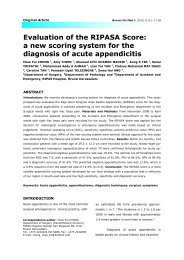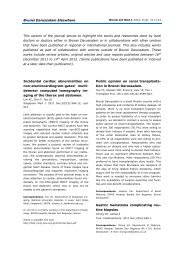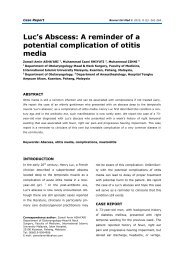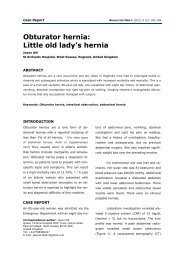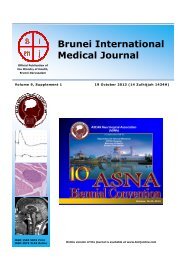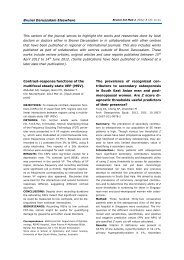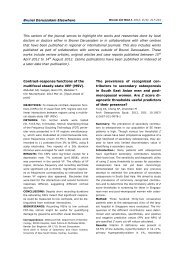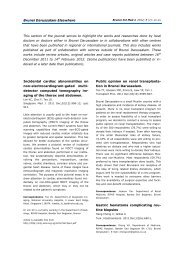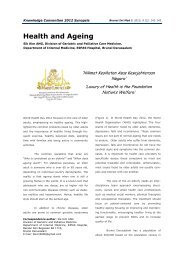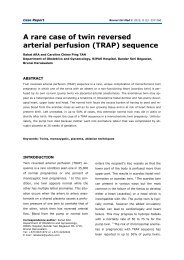Actinomyces naeslundii: A rare cause of chronic purulent canaliculitis
Actinomyces naeslundii: A rare cause of chronic purulent canaliculitis
Actinomyces naeslundii: A rare cause of chronic purulent canaliculitis
- No tags were found...
You also want an ePaper? Increase the reach of your titles
YUMPU automatically turns print PDFs into web optimized ePapers that Google loves.
FRANCIS et al. Brunei Int Med J. 2013; 9 (2): 119Fig. 1: Chronic <strong>canaliculitis</strong> with pouting punctum.fibrillation, mitral regurgitation and sick sinussyndrome with an implanted permanent cardiacpacemaker. Examination showed a wateryleft eye with <strong>purulent</strong> discharge and mattedlashes. There was associated erythema andswelling <strong>of</strong> the inner end <strong>of</strong> the lower eyelidand medial angular congestion. The lowerpunctum was stenosed (Figure 1), and appearedred, swollen and pouting. The lowerpunctum and canaliculus was tender to gentledigital manipulation which expressed a thickwhite tenacious discharge containing solidpale-yellow sulphur granules (Figure 1). Thelower canaliculus was strikingly thickened.Probing <strong>of</strong> the left upper canaliculus revealeda ‘hard stop’ whilst that <strong>of</strong> the lower canaliculuswas gritty in nature with a ‘s<strong>of</strong>t stop’.Chronic dacryocystitis was also identified inthe same eye as evidenced by regurgitation <strong>of</strong>mucoid substance when the upper punctumwas irrigated with saline. revealed immaturethe lower canaliculus sample revealed Grampositive cocci in small groups and pairs withlarge numbers <strong>of</strong> gram positive branching filaments(Figure 2), while that from the uppercanaliculus showed chain forms <strong>of</strong> gram positivecocci. Culture <strong>of</strong> the lower canaliculussample showed pr<strong>of</strong>use growth <strong>of</strong> A. <strong>naeslundii</strong>along with Staphylococcus aureus whilstthat <strong>of</strong> the upper canaliculus showed a moderategrowth <strong>of</strong> Streptococci Lancefield groupF.Based on the antibiotic sensitivity, shewas started on oral doxycycline, 100mg twicedaily with topical cipr<strong>of</strong>loxacin drops fourtimes a day. However doxycycline had to bediscontinued two days later following the development<strong>of</strong> dyspepsia and was replaced withcataracts in both eyes and evidence <strong>of</strong> drynessin the right eye.A working diagnosis <strong>of</strong> left <strong>chronic</strong>dacryocystitis with ipsilateral lower <strong>purulent</strong><strong>canaliculitis</strong> was made. The expressed <strong>purulent</strong>materials from upper and lower canaliculiwere separately sent for bacteriological analysisand sensitivity testing. Gram-staining <strong>of</strong>Fig. 2: <strong>Actinomyces</strong> <strong>naeslundii</strong> under gram stain,branching filaments are indicated by white arrow(H&E stain Magnification x40).



